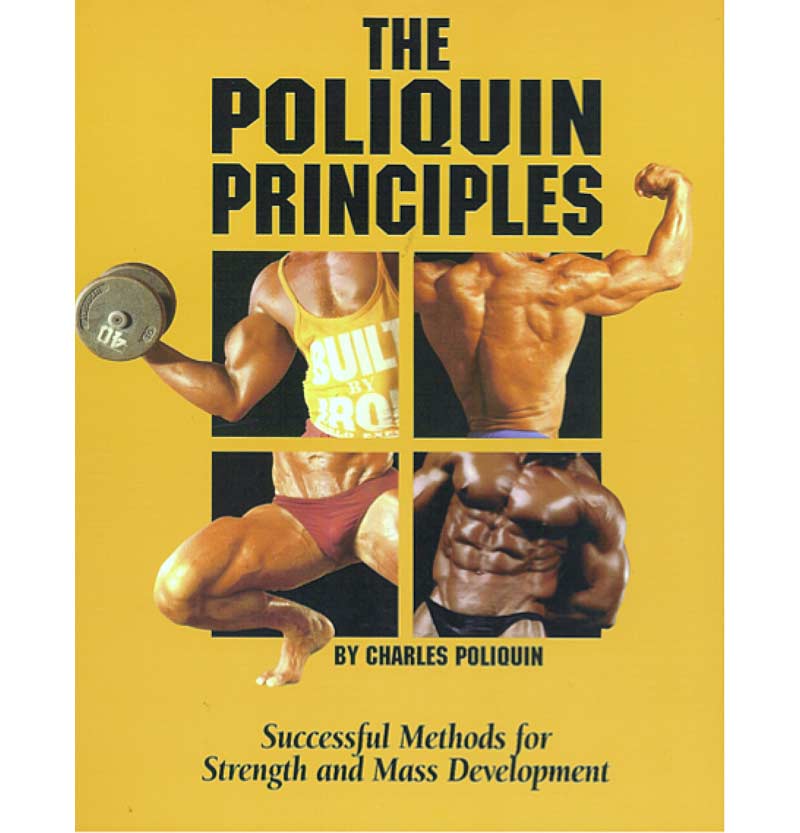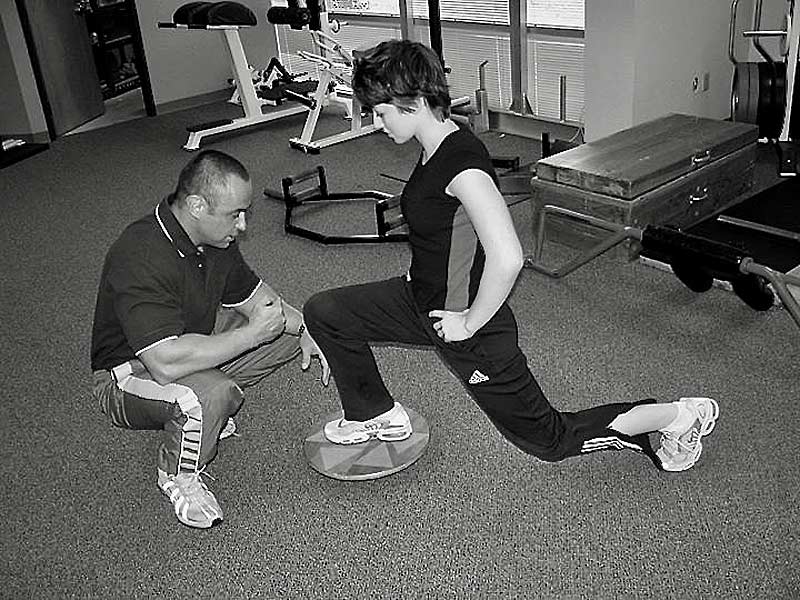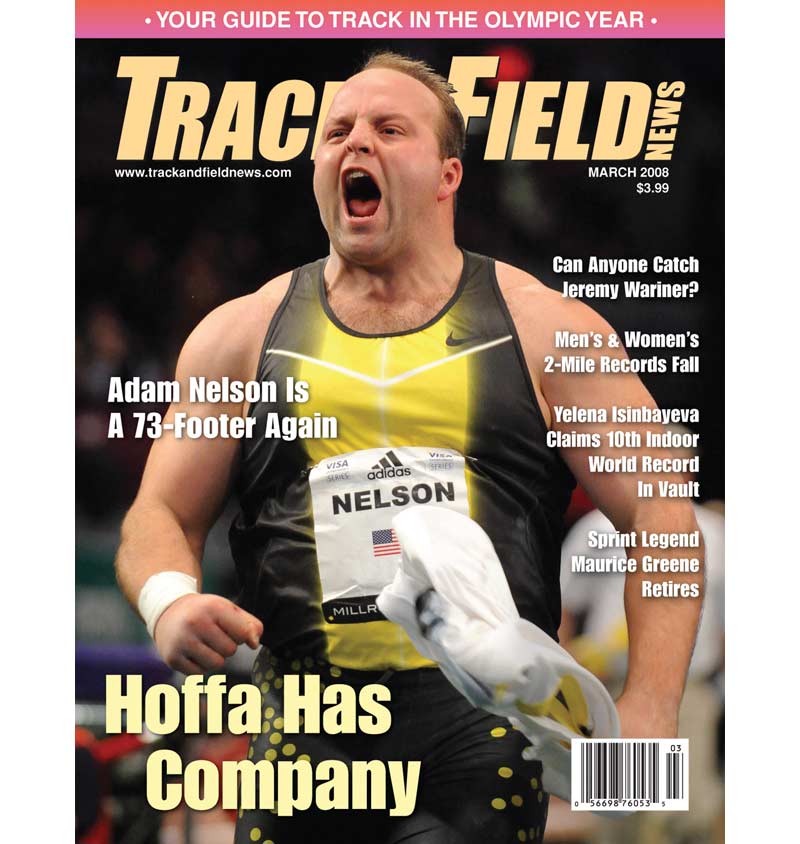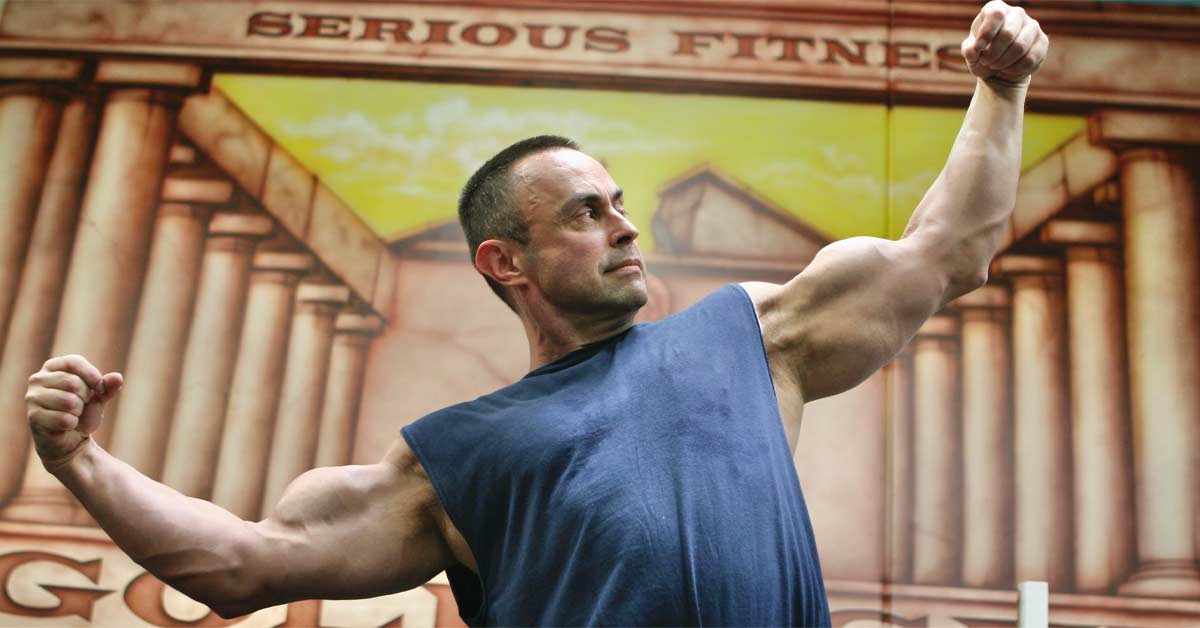German Volume Training, German Body Comp, and four-digit strength training tempo prescriptions are training methods commonly practiced today. What do they all have in common? Charles Poliquin, a Canadian strength coach who introduced these ideas and many others to the athletic and physical fitness communities.
For those new to the Iron Game, Poliquin coached Olympians in two dozen sports and hundreds of elite athletes in other sports. In track and field, he worked with 2004 gold medal winners Dwight Phillips (long jump) and Adam Nelson (shot put), and in 1999 worked with Jamaican hurdler Michelle Freeman, an Olympian who now coaches at the University of Virginia. But we’re getting ahead of ourselves. As a strength coach, Poliquin “talked the walk” and, spouting 19+ inch bone-crushing pythons for arms, “walked the talk!”
In contrast to today’s abundance of strength coaching and personal training organizations offering journals edited by PhDs, muscle magazines were one of the primary sources of training information in the early days of strength coaching. Flex, Iron Man, Muscular Development, and Muscle Media 2000 were among those publications treasured by strength coaches responsible for getting their athletes competition ready. Poliquin became one of the most popular writers for these magazines, and in 1997 assembled his best writings into his classic, The Poliquin Principles.
(Lead photo by Miloš Šarčev.)

Poliquin distinguished himself from his colleagues with the use of precisely controlled “loading parameters.” Loading parameters include training variables such as reps, sets, tempo (lifting speed during all phases of an exercise, a system he modified from a three-digit formula developed by Australian strength coach Ian King), and rest. For example, an exercise prescription for the upper body might look like this:
- A. Dumbbell Bench Press, 45-Degree Incline, Pronated Grip, 5 x 6-8, 3101, rest 45 seconds
This formula would tell you the exercise order, name of the exercise and type of resistance, body position, grip, sets, repetition range, speed of muscular contractions (eccentric, isometric, and concentric), time under tension, and rest period. For example, here is a leg workout Poliquin wrote for Phillips, the gold medal winner he started training in February 2004.
- A. Power Clean from Above Kneecap, 4 x 4-6, 40X0, rest 120 seconds
– Make sure shoulders are ahead of the bar at the start
- B. Telemark Inertia Quarter Squat, 4 x 4-6, 40X0, rest 120 seconds
– Go to ankle flexibility
- C1. 1 ¼ Front Squat, 4 x 4-6, 40X0, rest 120 seconds
– Quarter rep in the bottom position
- C2. Atlantis Kneeling Leg Curl, Neutral, 4 x 4-6, 40X0, rest 120 seconds
– Foot is pointing away and neutral
Before writing an athlete’s workout, Poliquin performed a muscular balance assessment, a system inspired by the training programs of European weightlifters. Poliquin believed that to achieve optimal performance with minimal risk of injury, you must address specific ratios of strength imbalances between muscle groups.
Poliquin believed that to achieve optimal performance with minimal risk of injury, you must address specific ratios of strength imbalances between muscle groups. Share on XConsider the bench press: Poliquin found that if the muscles that externally rotate the shoulders were weak, this imbalance could affect bench press performance and increase the risk of injury. When pro hockey player Jim McKenzie met Poliquin, he could lift 280 pounds in the close-grip bench press (hands about 14 inches apart). That result is quite remarkable for a hockey player, but Poliquin wasn’t impressed.
During his assessment, Poliquin found that McKenzie’s rotator cuff strength was especially weak. As a result, for the next three months, McKenzie did not bench press; instead, Poliquin had him focus on improving his rotator cuff strength. However, at the end of this training period, McKenzie bench pressed 331 pounds; again, no bench pressing. At this point, Poliquin reintroduced bench pressing, and six weeks later, McKenzie close-grip bench pressed 380 pounds!
Included in Poliquin’s assessment are what could be considered “functional tests.” Upon his initial assessments for long jumper Phillips, Poliquin found a muscular imbalance between his hamstrings and a quadriceps muscle called the vastus medialis oblique. Before prescribing exercises to help Phillips run faster and jump higher, he began with corrective exercises to address these imbalances.
I first saw Poliquin demonstrate several of these tests at a seminar I attended in the early ’90s in California. One of the critical tests for the lower body he taught was an expanded version of a knee stability test developed by Lois Klatt, Ph.D.
The Klatt test is performed barefoot. Standing on the edge of a low platform, Poliquin had the trainee extend one leg at a 15-degree angle, then hop off. How the trainee lands determines what muscles are weak and what corrective exercise should be prescribed. For example, leaning forward as they land could suggest a weakness in the gluteus maximus; corrective exercises could be reverse hypers or good mornings. Hopping forward could suggest a weakness in the hamstrings; corrective exercises could be leg curls or Romanian deadlifts.

Before getting into some of Poliquin’s most popular workouts, let’s explore how he became a strength coach.
The Education of a Strength Coach
As an athlete, Poliquin dedicated himself to learning the martial arts, and at age 14, he became the second-youngest athlete in Canada to earn a black belt. His sensei was Web Corcoran.
Poliquin took the bus to the dojo. During one snowstorm, the buses were not running, so he walked. However, no other students showed up. Rather than conducting a private lesson, Corcoran invited the future strength coach to lift weights with him. Poliquin was hooked and set out to pack on muscle and become as strong as he looked.
It was only natural for Poliquin to major in exercise physiology in college. For his master’s thesis, he examined the optimal loading variables for developing strength. During his studies, Poliquin discovered that the best research on resistance training could be found in European sports science journals, particularly those from Germany. Unfortunately, only the abstracts of these studies were published in English and French, so his passion for knowledge led him to learn German.
His education didn’t end there.
Not only would Poliquin travel the world to attend seminars, but he would also seek out experts in fields he was interested in and offer to pay them for personal consultations. Share on XNot only would Poliquin travel the world to attend seminars, but he would also seek out experts in fields he was interested in and offer to pay them for personal consultations. For example, twice I recommended he consult with athletic fitness experts I knew, and he flew to both ends of the United States to see and learn from them. I should also note that Poliquin was also a voracious reader, often devoting one full day each week to study (advice he gives to his students, explaining that “Learners are earners!).
With what could be considered a photographic memory and a mastery of speed-reading techniques, Poliquin read and retained the knowledge of hundreds of books each year. During question-and-answer sessions at seminars, Poliquin often looked upward and off to the left—which he said was the side of the brain that held memories—to recite specific passages from research studies. He also hired graduate students and colleagues to collect research papers, and he would read them during long flights. I met one of these helpers at an NSCA convention, and he showed me a foot-high stack of documents he collected for Poliquin.
From Theory to Practice
While attending the university and lifting weights, a volleyball player was impressed with Poliquin’s strength and asked Poliquin to write a workout for him. He quickly became the team’s strongest athlete, so other athletes asked Poliquin for workouts. Word spread, resulting in Poliquin being hired as the official strength coach for the national team to help them prepare for the 1984 Olympics.
Athletes and coaches from other Olympic sports in Canada learned of Poliquin’s abilities. Of the 118 Canadian athletes who competed in the 1992 Olympic, he coached 78, and five won medals. Two years later, seven of his athletes won medals at the 1994 Olympics. By then, the Canadian government pressured him to become a full-time civil servant. To keep his revenue stream growing, he looked for an opportunity to move to the United States.
On one of his visits to Colorado Springs, I introduced Poliquin to Dr. Mike Leahy, a chiropractor who developed the popular soft tissue treatment called Active Release Techniques (ART). Poliquin set out to master ART, which led to him eventually leaving Canada to work out of Leahy’s sports medicine facility. Also working out of that facility was Tim Patterson, best known for the popular website Testosterone.
Poliquin eventually decided that although Colorado Springs was a good place to work, Phoenix, Arizona, was better (although he seriously considered Las Vegas). The reason was that the airport was convenient for his national and international clients, along with the many pro athletes who lived in the area. So Poliquin set up his training gym a few miles from the airport in a quiet business district. I should mention that it was a private gym: no sign out front, just a number; so, if you didn’t know that number, you would never find it. One concern Poliquin had with the sports celebrities that trained there was that he didn’t want them distracted by fans.
The way clients would work with Poliquin was distance, but the difference was you had to fly out to see him twice a year for an assessment. Thus, you would fly out to his facility and go through testing that often included lab testing. One beneficiary of this testing was Adam Nelson. After his eventual gold in the 2004 Olympic Games, Nelson visited Poliquin in Arizona.
Nelson always had an issue gaining muscle, so Poliquin had Nelson submit to lab testing. The testing revealed that Nelson had a bacterium affecting his ability to assimilate protein, so he had his doctors treat this problem. Within three months, Nelson gained 25 pounds of solid muscle and decreased his body fat by 5%! Poliquin also found that Nelson had a shoulder injury that affected his pressing ability. He treated that with ART, and Nelson made dramatic strength improvements immediately.

Of course, Poliquin could only train so many athletes—so, to expand his audience, he focused on writing articles and books and giving seminars worldwide. In 1994, he told me he earned enough frequent flyer miles to travel around the world twice!
Of course, Poliquin could only train so many athletes—so, to expand his audience, he focused on writing articles and books and giving seminars worldwide. Share on XI met Poliquin at a strength coaching seminar in 1988. I was a strength coach at the Air Force Academy at the time, responsible for writing and supervising the workouts for all the major varsity sports. To give my athletes an edge, I did extensive research at the Olympic Training Center Library in Colorado Springs to find everything Poliquin ever wrote and began calling him weekly.
Over the next two years, my long-distance bill to Canada equaled a month’s salary! But this investment was worth it, as I wanted to thoroughly understand what he did with athletes and why he did it. Further, with an athlete base that expanded to 875 athletes during my final year, I could effectively assess the effectiveness of Poliquin’s training methods. Two of these methods were the German Volume Training (GVT) and German Body Comp (GBC) programs.
The German Connection
Shortly after I started consulting with Poliquin, I spoke to him about a minor league hockey player, Craig Shepherd, who wanted to bulk up to market himself as an enforcer. Poliquin told me about a program he called German Volume Training. It involved executing a few “best bang for your buck” exercises, such as squats and bench presses, and performing them for 10 sets of 10 reps.
In less than three months, my hockey player gained more than 40 pounds of body weight, power cleaned 285 pounds, and bench pressed 400 pounds! Interestingly, later in his career he lost all that weight and got recruited to play for Moscow Dynamo in Russia. After that, he became a professional skater in pairs competition, teaming up with 1992 Olympic champion Natalia Mishkutionok.
The next German-inspired program was called German Body Comp. I had called Poliquin about the female figure skaters I was working with who needed to lose body fat. He told me about a program using short rest intervals designed to lose body fat quickly without compromising strength or muscle mass. In 10 weeks, without significantly changing her diet (in fact, we increased her calorie intake significantly), one skater went from 148 pounds to 104 pounds. I wrote an article about the program for Skating magazine and a mainstream fitness magazine (although I called it the German Body Shaping System), and later Poliquin and I teamed up to produce an article for Muscle Media 2000.
Poliquin’s books and seminars were financially successful and influenced countless coaches and athletes. For three decades, I was Poliquin’s primary editor. I helped him write articles, books, training courses, and countless question-and-answer columns. I’ve lost track of how much material we produced (much that was never published), but I’d estimate it was north of a quarter of a million words. We parted ways in 2013 when he started a new company called Strength Sensei, Inc., but Poliquin continued producing written material, particularly with Testosterone and former Muscle Media 2000 editor T.C. Luoma.
Throughout our three decades together, Poliquin championed other programs that many strength coaches or personal trainers were unaware of, including the 1-6 Method, the Patient Lifter Method, cluster training, and the Modified Hepburn Method. He also wrote and lectured extensively about lifestyle, nutritional supplements, and how to use body fat testing to assess hormonal balance. Poliquin left us on September 26, 2018, passing his company to his daughter Krystal.
Charles Poliquin’s pioneering training methods and commitment to teaching helped shape the modern world of strength and conditioning. Share on XPoliquin “talked the walk” and “walked the talk” in the world of physical fitness and athletic fitness training. It’s been said that “legends never die,” and in the case of this remarkable strength coach, it’s true. Charles Poliquin’s pioneering training methods and commitment to teaching helped shape the modern world of strength and conditioning.
Since you’re here…
…we have a small favor to ask. More people are reading SimpliFaster than ever, and each week we bring you compelling content from coaches, sport scientists, and physiotherapists who are devoted to building better athletes. Please take a moment to share the articles on social media, engage the authors with questions and comments below, and link to articles when appropriate if you have a blog or participate on forums of related topics. — SF






